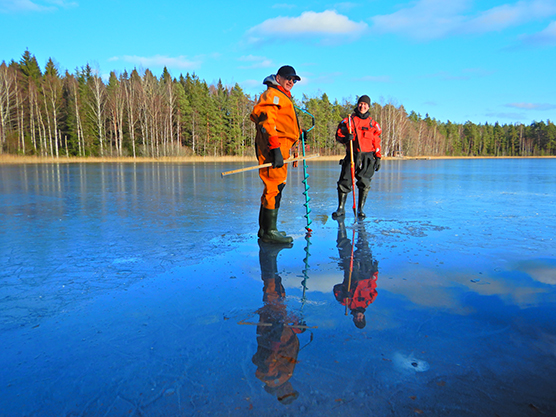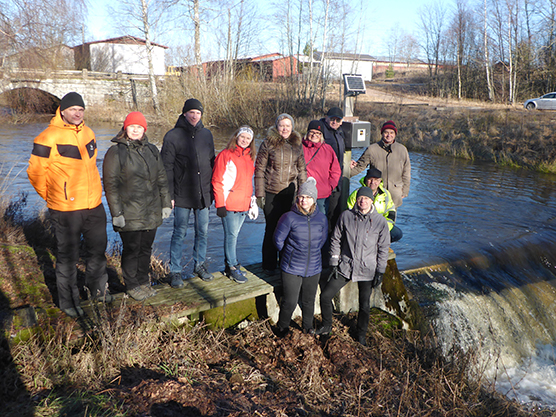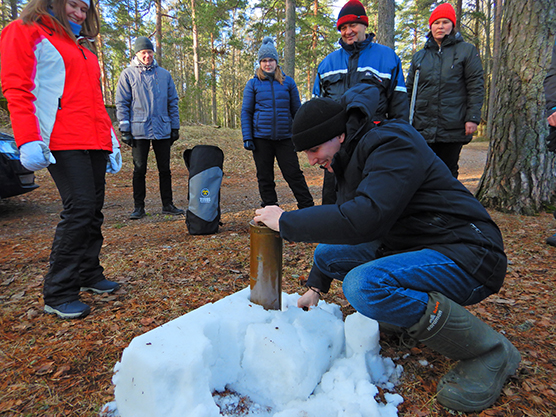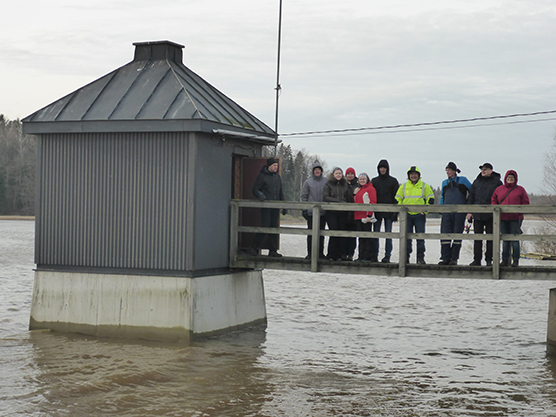
Pekka Vähänäkki and Alexander Ipatov measuring lake ice thickness in survival suits. © Johanna Korhonen.
SEVIRA project arranged third hydrological joint monitoring event in 19th - 21st of February. Finnish and Russian experts gathered in Virolahti region to perform winter time hydrological measurements. An exceptionally mild February surprised hydrologists and made to do some minor changes to the planned program.
The event consisted of presentations by Finnish Environment Institute SYKE's experts, visits to hydrological stations, demonstrating snow cover, ground frost and ice thickness measurements and meeting local observers. There were altogether 13 participants: four experts from Russia (NW AHEM), four SYKE experts and three KAS-ELY (Centre for Economic Development, Transport and the Environment for Southeast Finland) experts and two local observers (hydrology and marine).
The timing of the joint monitoring event was planned in advance according historical hydrological data to guarantee winter conditions for measurements. An exceptionally mild February surprised hydrologists - there was no snow, only very little lake ice and river discharges were close to mean spring maxima instead of winter minima. These changing conditions brought a few changes to event program, but the joint event was successfully accomplished.
Presentations related to following measurements in Finland were presented by SYKE experts: measurement techniques and practices related to snow water equivalent, ice cover, ground frost, water level and small catchments. A local Ravijoki small basin observer Pasi Saarainen told about his experiences with hydrological monitoring.
The joint monitoring delegation visited Virojoki hydropower dam and Virojoki (Salmen silta) automatic water level station upstream. Also Hamina sea water level station (mareograph) was visited and local observer Toni Tuomala was met. Differences and similarities in lake/river and sea water level measurements were discussed. Also Ravijoki small basin measurement weir and ground frost tubes were visited and read. A reporter interviewed participants for writing news to local newspaper of the event.
There was no snow on the ground in Virolahti, so natural snow line measurements were unable to perform. However, KAS-ELY expert Pekka Vähänäkki was well prepared and had taken an adequate amount of snow to the freezer earlier this year. It was enough to perform demonstration for snow water equivalent measurements with a snow tube and a scale. Ice cover in lakes was mostly absent but a lake with very thin ice cover was found in the area. Measures of precaution were taken into account and ice thickness was measured in survival suits (Russian expert Alexander Ipatov and Finnish expert Pekka Vähänäkki). Measurement results showed ice cover of 7 centimeters. Also Russian colleague did a test for using survival suit to rescue oneself from the ice hole with ice claws. That was planned test from a ready made hole.
In addition to professional program, the event included social evening program to visit Salpa line bunkers, getting to know Harju Manor Learning Center, visiting Kiessi museum and Vahtivuori leisure area. The evenings in Harju Learning Center were filled with fruitful conversations exchanging knowledge and culture between Finns and Russians.
Participants are looking forward the next hydrological joint monitoring event to be held in Russia in autumn 2020.

Participants visiting Ravijoki small basin observation station. © Pekka Vähänäkki.

Demonstrating snow water equivalent measurements preserved/ frozen snow. © Johanna Korhonen.

Participants visiting Hamina sea water level station (mareograph). © Pekka Vähänäkki.